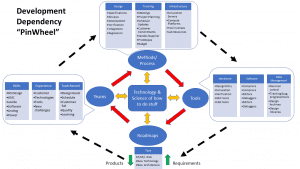This is a first pass at development dependency “pinwheel” model for intrapreneurs fostering new capability development and executives adjusting a product roadmap for development risk.
Mapping Capability Development Objectives to New Product Design and Delivery Projects
Mapping Capability Development Objectives to New Product Design and Delivery Projects
I pulled this short briefing together three months ago to kick start a set of conversations with enterprise change agents. I am posting this as a blog to reach out to change agents we have not had a chance to speak to already. You can leave a comment, contact me directly at SKMurphy or use this form to start a conversation.
We Want to Help People Drive Customer-Focused Change in Their Organization
We want to help people drive customer-focused change in their organization. We also want to be able to have a conversation with them. We want to use a model or a framework to help them plan and deploy, and also use that model or framework to discover changed opportunities.
We came up with this model here. I know it’s a busy slide but I wanted to put down all of the relevant information. We start with the roadmap. Roadmap defines basically where you are today in terms of product, and where you want to be in the future. We have teams; teams pick up requirements from the roadmaps. They use methods and process to develop the product, and they drive those methods with tools to create the product. The product then turns out through the roadmap and into customers.
So, we have the what, the roadmap; we have the who, the teams; and we have the how, when, and where: the methods and process. Methods and process outline how, when, and where to do tasks in the development timeline. And then we have the means which are the tools.
The glue in the center–science and technology–is really all about learning and education. To hit the product goals on the roadmap, you’re going to learn a lot as you go, getting an education from customers, the marketplace, and competition. At a team level learning enables to improving their skills and their knowledge, which are supported and embedded in your tools and methodology.
Each of these areas is subject to ongoing assessment. For roadmaps, you can slice and dice it by risk: high, medium and low. Slice it by technologies you’re using, all the different architectures. Think carefully about metrics you can use to gauge your roadmaps. You will need metrics for teams to measure skills, experience, and track record, so that you can get a feeling for their capabilities. You could look at for your methodology to assess coverage and complexity, tools, accuracy, state of the art. There’s a number of ways you can assess each of these areas.
You Have to Tie Internal Innovation to New Products or Services
The bottom line is if you’re trying to implement any kind of change, you have to look at these four and learning and education at the same time. You can’t just focus on one or two of them and expect that change to happen. I’ve seen a lot of times, people come in with a new method that they’ve got from either their previous job or they’ve heard of and they and drive it to the organization. They do the right things, they put together presentation, they try to get alignment in the organization. They’re trying to sell it to the right people, key stakeholders and that kind of stuff, but if they don’t have a product that’s going to use that method and teams that are going to drive that product, to drive that method. And just some understanding of what is going to take in terms of the what, the tools, that are needed to scale that method, then it’s very painful. And that new method probably won’t make it into the organization.
The Gap Between Current Capabilities and Roadmap Requirements is the Opportunity for Change
You can also use this to look at opportunities, too, because if anyone of these boxes is out of alignment with the others, then there are gaps. When you have gaps, you have opportunities. You can look at the roadmap and look at team’s capabilities. Inherently, if the road map is aggressive enough, you’re going to have a gap between what the team’s capable of today and what they need to be capable of tomorrow to meet the new product requirements. So that gap could be in skills, tools, methods, and/or processes.
The thing that is important understand is that this gap is an opportunity for change. To drive change, you need to understand how big that gap is. It might not be possible for a team to close that gap quickly enough, in which case you might want to break up the gap into smaller, manageable pieces, and close the gap in a multi-step process. All you may want to solve it with the product and come up with incremental releases until you finally have all the skills and capabilities to produce the full featured product.
 Next Steps
Next Steps
As I mentioned at the start you are looking at a work in progress, a briefing I put together three months ago to kickstart a set of conversations with enterprise change agents. If you are working as a change agent or are interested in fostering more customer focused innovation I would welcome your comments and suggestions: contact me directly at SKMurphy or use this form to start a conversation.
Related Blog Posts
- Innovation Inside an Organization Requires Balancing Priorities
- Managing Change in an Organization: An Incomplete Resource List
- Q: Best Practices For Finding Early Adopters
- Jerry Weinberg interview
- Steve Hodas’ Lean Startup 2013 Talk Offers Recipe for Re-Invigorating Intrapreneurs
- Jeff Allison: How To Blend New Capability and New Product Development
- Jeff Allison joins SKMurphy Team to Drive Intrapreneur Focus for 2017
